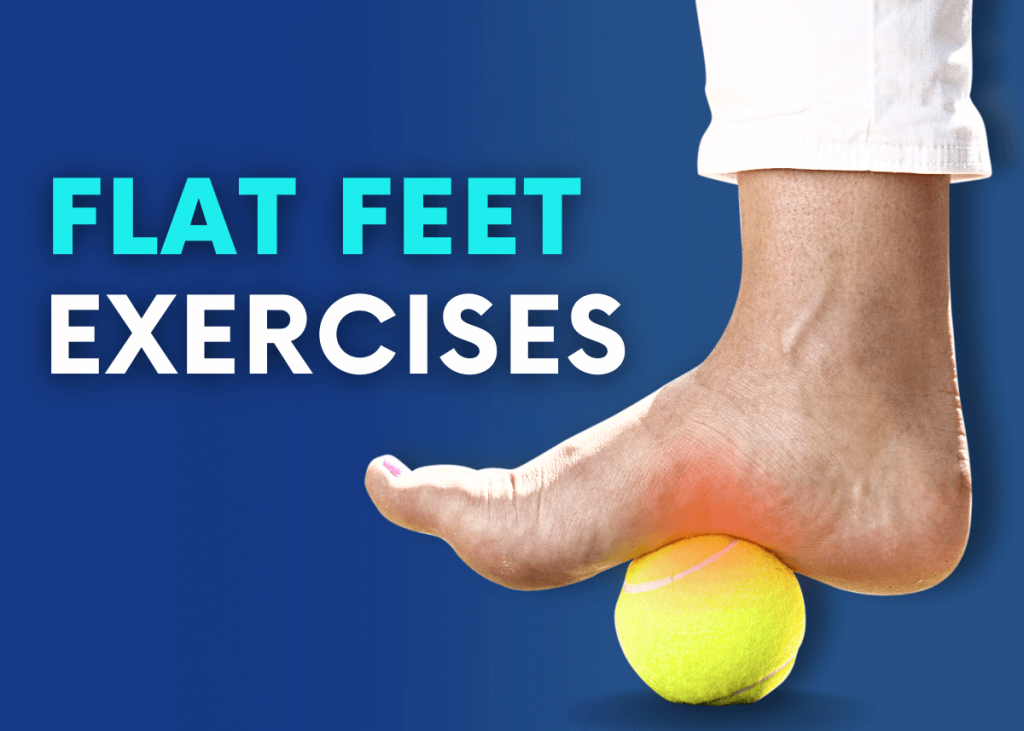
Flatfeet is a condition in which the curved shape of the sole of the foot disappears and the sole flattens as a result of causes such as weakness of some muscles and tendons in the sole of the foot, improper fusion and development of bones. If this condition causes pain in the foot and leg and difficulty walking, it may be a case of hard flatfeet and is problematic for the function of the foot. Flatfeet exercises are an effective treatment for treating foot pain and restoring normal foot function. In this article, we will provide information about flatfeet exercises and explain how people with flat feet can benefit from them.
Table of Contents:
- What is Flatfeet (Pes Planus)?
- How is Flatfeet Diagnosed?
- What are the Symptoms of Flatfeet ?
- Non-Surgical Treatment Methods
- Flatfeet Exercises
- Can flatfeet be corrected with exercise?
What is Flatfeet (Pes Planus)?
Flatfeet (Pes Planus) is a disruption of the arch of the foot, known as the loss of the arch on the inside of the sole of the foot (medial longitudinal arch), in which this area of the foot approaches the ground or collapses to the point of contact with the ground. The longitudinal arch of the foot in the middle is formed by the strong interconnection of ligaments, tendons and fascia between the forefoot and hindfoot (Picture 1). Flatfeet can occur due to loosening of these soft tissues that form the arch on the inner side of the sole.
These tissues, which hold the joints of the feet together, act as a support for the whole body and distribute weight-bearing forces.
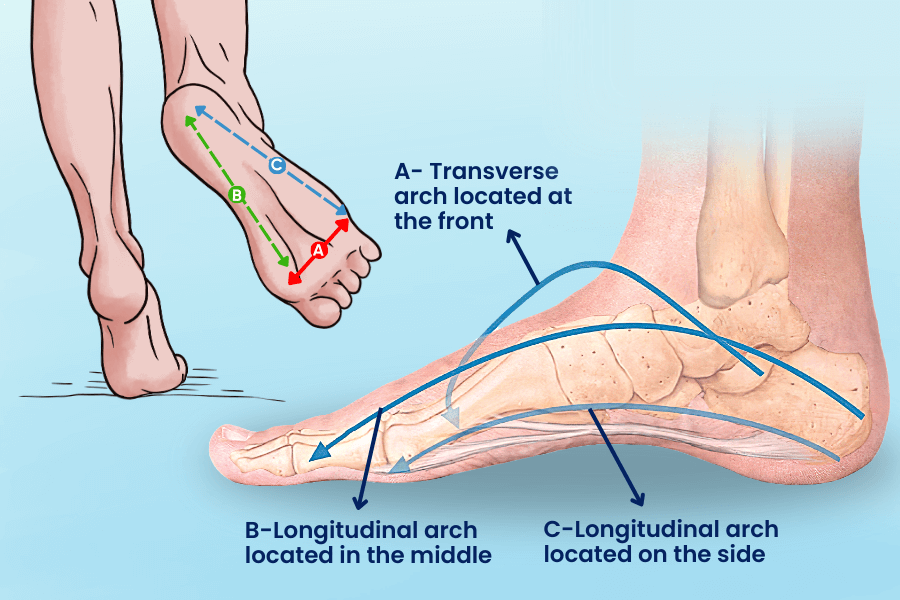
How is Flatfeet Diagnosed?
Flatfeet is diagnosed in the same way in adults and children. During the examination, your doctor will examine the condition of your foot and ankle while sitting, standing and walking. He will also make assessments by asking you to stand on your toes first to observe the internal arch angle in the sole of your foot, and then to lift your big toe by returning your foot to its original position.
Flatfeet is divided into two types: flexible and rigid Flatfeet .
1. Flexible Flatfeet
If the sole of the foot is flattened when standing; if it curves when sitting or standing on tiptoe, flexible Flatfeet is in question. It is a condition that usually does not affect the daily life of individuals.
2. Hard Flatfeet
If the arch does not form on the inside of the sole of the foot and pain is felt during movement, both when stepping and in positions such as sitting, where no load is placed on the foot, hard flatfeet is in question. In this case, some radiological imaging tests should be performed to examine the foot structure more closely. These tests are as follows.
- X-ray: Both feet are taken with both feet on the ground and compared.
- Computed Tomography (CT): Bone structures in the foot are evaluated.
- MRI (Magnetic Resonance Imaging): Soft tissues in the foot are monitored in detail.
Is Flatfeet Dangerous?
Flexible flatfeet usually does not require treatment as it does not pose a risk in children and adults. In such cases, it is recommended to choose shoes that support the inner arch of the foot.
However, if pain starts to occur, you should consult a doctor. Various treatments may be considered as a result of the tests and examination. It is recommended to consult an orthopedic doctor to learn about the conditions that require treatment and treatment methods for flexible flatfeet .
Is Flatfeet Genetic?
Flatfeet in children also develops due to hereditary factors. Flatfeet is more common in children of other family members with flatfeet . In addition, flat feet are common in children with diseases such as Down Syndrome, Cerebral Palsy, Ehlers-Danlos Syndrome (a condition in which the ligaments are excessively flexible).
What are the Symptoms of Flatfeet?
Although it occurs in adults and children for different reasons, the symptoms are similar. These symptoms:
- The arch of the foot is flattened,
- The heel bone is turned outward,
- Foot, ankle, calf, knee, leg or lower back pain,
- Strain and discomfort in the foot when running, walking or wearing shoes,
- It can be listed as pain in the soles of the feet and ankles when weight is placed on the foot or when standing for a long time.
One of the curious questions about flatfeet is “Are flatfeet and flat feet the same thing?”. The tendency of the foot to press inwards is one of the symptoms of flatfeet. When looking at these people from the back, it is observed that the heel bone is in an outward-facing position.
Flatfeet in Adults
In adults, the soft tissues in the foot can be damaged as a result of aging, bruising, injury or various diseases. Such conditions can lead to flatfeet in a person who already has a normal inner arch. This type of flatfeet is not bilateral but may occur on one side only.
Flatfeet in Children
The arches of the feet of newborn babies resemble flat feet because they are not sufficiently developed. As you grow and walk, the soft tissues under the feet stretch, which gradually allows the arches of the feet to take shape. Due to genetic factors, the arch structures of the feet are not shaped or flexible flatfeet persists until adolescence, and pain in the lower parts of the feet can be observed.
Up to How Old Can Flatfeet Correct?
In healthy children with congenital flatfeet , it is observed that flexible flatfeet disappears between the ages of 3 and 5 as the arch of the foot begins to form.
Non-Surgical Treatment Methods
Flatfeet usually does not require treatment unless it causes significant pain and difficulty walking. In painful cases, non-surgical (conservative) treatment methods are primarily applied. These include:
- Flatfeet exercises,
- Custom-made orthotic insoles that support the arch of the foot and are inserted into shoes,
- Choosing well-fitting, supportive shoes,
- Use of painkillers and anti-inflammatory drugs,
- Prolotherapy injections to tighten the connective tissues in the soles of the feet,
- It includes physical therapy and rehabilitation program applications.
Flatfeet Exercises
Although people with flatfeet do not experience significant health problems, they should be more careful when they are physically active. Because the soft tissue in their feet is weak, the muscles continue to weaken if they use insoles. Flatfeet exercises recommended to prevent this are important for these tissues to strengthen and provide the necessary structural support to the foot. So, which muscles do flatfeet exercises work?
Flatfeet exercises aim to work the calf, ankle and sole muscles. Exercises should be continued as long as no significant pain is felt. Flatfeet exercises are based on stretching strained muscles such as the calf muscle and achilles tendon and strengthening the muscles that support the arch of the foot. Flatfeet exercises should be programmed by specialists specifically for each person.
Unless otherwise directed by your doctor or physiotherapist, the flatfeet exercise program should be continued every day for 4-6 weeks and then at least three times a week. After your recovery, it is useful to continue as a maintenance program for the health of foot and leg function. Doing the exercises three to five days a week will maintain strength and range of motion in your foot and ankle.
Flatfeet Stretching Exercises
To prepare for the exercises, walking for 5 to 10 minutes beforehand and doing preparatory exercises to stretch the muscles will allow you to complete the flatfeet exercises without damaging the muscles and tendons.
Achilles Tendon Stretching Exercise
In this exercise, the tension is felt in the calf, the sides of the ankle and the heel.
- Place your non-flat foot forward and slightly bent at the knee, facing the wall. Meanwhile, your flat-footed foot should be straight behind you and both heels should be flat on the ground.
- Once in position, press your body against the wall.
- Stay in this position for 30 seconds and then relax for 30 seconds.
- Repeat the exercise 10 times in 2 sets.
- It is recommended to do the exercise 6 or 7 days a week.

Achilles Tendon Stretching Exercise with Knee Bending
In this exercise, the tension is felt in your calf, the sides of your ankle and the heel.
- As in the previous position, place your non-flat foot forward and slightly bent at the knee, facing the wall. Then hold the flat foot behind the back, bent at the knee.
- Press both heels flat on the floor.
- Once in position, press your body against the wall.
- Stay in this position for 30 seconds and then relax for 30 seconds. Do this 5 times.
- Repeat the exercise 2 times a day.
- It is recommended to do the exercise 6 or 7 days a week.

Achilles Tendon Stretching Exercise with Towel
In this exercise, the tension is felt in the calf and heel.
- Sit on the bed or on the floor with both legs stretched forward.
- Wrap the sole of your flatfeet with a towel. But place the towel close to the finger roots. Grasp the ends of the towel with your hands.
- Keep your leg straight. Gently pull the towel towards you. This will stretch the tissues behind the calf and ankle.
- Hold for 30 seconds and then relax for 30 seconds.
- Repeat the exercise 3 times.

Golf Ball Rolling Exercise
In this exercise, the tension is felt on the bottom of the foot.
- Sit on a chair with both feet on the floor.
- For 2 minutes, place a golf ball or another ball of the same size on the sole of your flatfeet and roll it.
- Repeat this exercise once every day.

Flatfeet Strengthening Exercises
Strengthening the muscles that support your lower leg, foot and ankle will help keep your ankle stable. Keeping these muscles strong can relieve foot and ankle pain and prevent further injury.
Standing on the Toes of One Foot
In this exercise, the tension is felt in the calf.
- Stand with your weight evenly distributed on both feet. Hold the back of a chair for balance.
- Lift the non-flat foot off the ground so that all your weight is on the flat foot.
- In this position, raise the heel of the painful foot as high as possible, then lower it.
- Repeat the exercise 2 sets a day, 10 times each set.
- It is recommended to do flatfeet exercise 6 or 7 days a week.
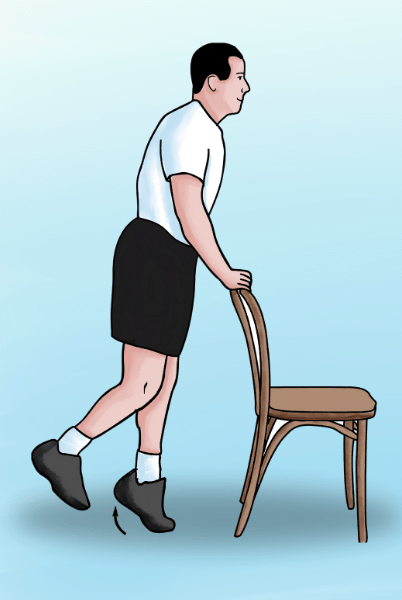
Ankle Exercisesistrong,
this exercise, the tension is felt on the top of the foot and along the ankle.
- Sit on a high seat so that your feet do not touch the floor.
- Try to write each letter of the alphabet in the air, guiding your foot with your big toe.
- Do this exercise 2 times a day.
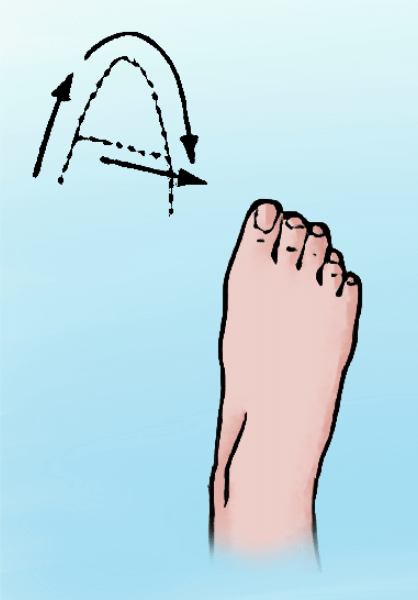
Towel Grip Exercise with Toes
In this exercise, the stretch is felt on the top of the foot and in the fingers.
- Sit with your feet flat and place a towel under your flatfeet .
- With your toes, grab the center of the towel and curl it towards you.
- Drop the towel and relax.
- Repeat the same exercise 5 times during the day.

Ankle Exercises with Elastic Band
In this exercise, the tension is felt in the calf, shin, back of the heel and top of the foot. It is recommended to use an elastic band to provide resistance during exercise.
- Sit on the bed or on the floor with your legs straight in front of you.
- To keep the elastic band in place, attach it to the leg of a table and place the band over the top of your foot.
- Pull your ankle and toes towards you and hold for 10 seconds and then slowly return to the starting position.
- Repeat this movement 10 times.
- This time, place the elastic band on the sole of your foot under the root joints of your fingers and hold the ends of the band with your hand.
- Slowly press your toes down, stay like this for 10 seconds and then slowly return to the starting position.
- Repeat this movement 10 times.
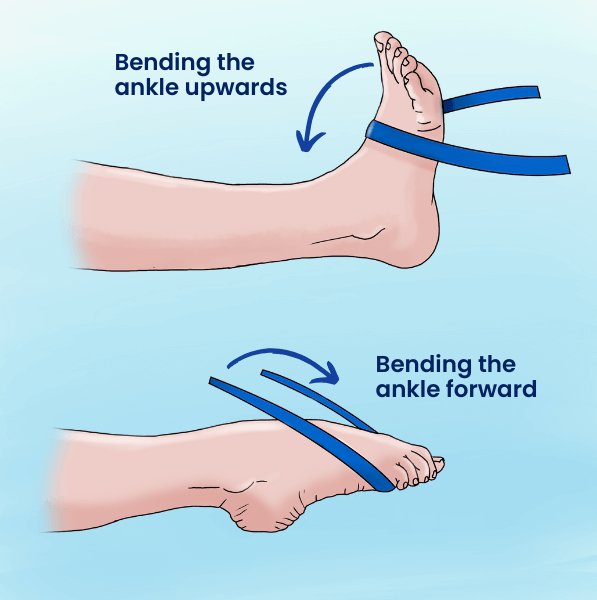
Can flatfeet be corrected with exercise?
Flatfeet exercises can only relieve the symptoms and pain of flatfeet by strengthening the muscles. Research shows that flatfeet exercises are not effective in individuals with significant foot deformities.
Flatfeet Surgery
Surgery is rarely needed to treat flatfeet , but in cases where conservative treatment options are inadequate, surgery may be required to solve the problem. So, can flatfeet be corrected by surgery?
The aim of the surgery is to eliminate pain, improve mobility and stop the progression of flatfeet . Depending on the patient’s condition, various procedures such as tendon transfers, tendon lengthening, joint fusion and implant placement can be performed.
Most of the time, flexible flatfeet does not require treatment and individuals with flat feet from childhood do not face any problems in their daily lives if they do not feel pain in adulthood. However, if hard flatfeet is left untreated, foot function is severely affected.
If you think that your child or yourself has symptoms of flatfeet , you can contact your Orthopedic doctor for information on necessary precautions and treatments.







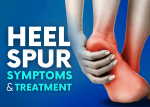

Leave a Comment